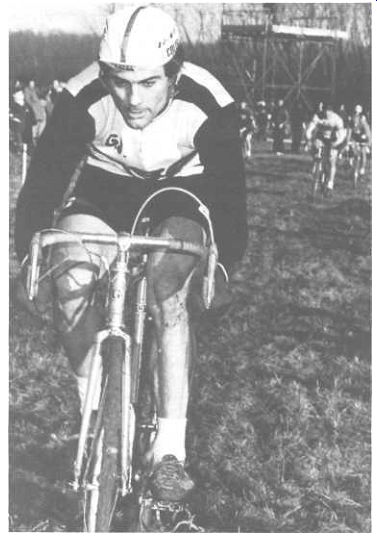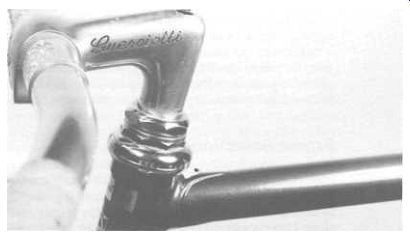Guerciotti
Via Petrella 4 Milano 20124 Italia
In 1962 the Guerciotti brothers, Italo and Paolo, started a small bicycle store in Milan. They brought with them many years of experience as riders as well as mechanics. Italo liked road races and cyclo-cross. His best performance was a first-place finish in the 1959 Italian cyclo-cross championships, sixteenth in the 1959 worlds, and thirteenth in the 1960 worlds. In 10 years of racing, Italo won approximately 100 races. As a professional team member, he rode in many of the Italian classics like the Milan-San Remo and the Giro di Lombardia.
Paolo followed in his older brother's footsteps and began racing in 1960. He won 80 road races before he retired in 1965 to devote more time to the growing business. Unable to shake the desire to race, he started to cyclo-cross in 1967. He is still competing, and in the past 10 years, Paolo has won 50 races in amateur cyclo-cross.
Background The first few years at Guerciotti were devoted to establishing themselves in the community and to the planning and designing of the Guerciotti frames. These were hectic times since Paolo was still racing and, in order to keep their small business afloat, both Italo and Paolo were moonlighting as team mechanics. Italo had previously been a Cynar team mechanic and was able to secure positions for himself and Paolo as mechanics for both the Bianchi amateur and professional teams. Bianchi's decision to quit their sponsorship of racing teams in 1965 caused the Guerciottis to switch their emphasis to their store.
Building Philosophy
In 1965 the Guerciottis started building their frames as a full-time business. They hired their uncle Lino Tempesta, an experienced builder, to provide additional guidance. Lino had been building frames for Bianchi in Bergamo for 15 years. He knew how to "use a torch" and he was a superb artisan.
Their uncle's experience alone was not enough for Paolo and Italo. Before Paolo and Italo started building frames, they sought answers to the many unresolved questions involving bicycle design theory. They were interested in building a quality product that would respond to the racers' needs. In order to do this, they sought additional technical advice from Cino Cinelli. Paolo says that, "Mr. Cinelli is a very important man in bicycling. He is very clever and knowledgeable in all aspects of frame building. Mr. Cinelli was very instrumental in getting us started in frame building." Cino Cinelli provided the Guerciottis with frame design theory, brazing techniques, and the secrets of assembling individual frame parts, like the proper fitting of the chainstays in the bottom bracket.
Combining the elements of experience from their bicycle racing, their tenure as team mechanics, Cino Cinelli's frame building advice, and Lino Tempesta's frame-building experience, the Guerciotti frame was conceived. Today, almost 15 years later, the Guerciotti frame has established itself in the bicycle world.
The demand is so great that the Guerciotti order form is printed in four languages: German, French, English, and Italian. Although Guerciotti is most popular in Europe, it is quickly gaining popularity in the United States. U.S. Olympic rider George Mount has owned several Guerciotti frames although they are hard to recognize since they are repainted with his club colors. George rode one of his Guerciottis to a sixth-place finish in the 1976 Olympic road race in Montreal.
Paolo, Italo, and Uncle Lino did all the frame building at their Via Petrella location. By 1972 the demand for Guerciotti bicycles had grown to the point where they had to recognize the fact that they needed to expand their manufacturing capacity. Even the bicycle store facilities were too small to accommodate the increased business that they were developing year by year. Fortunately, a larger location was available just around the corner on Via Tamagno. This location was large enough for an assembly area, but was not suitable for frame building since Milan's city code prohibits the use of brazing torches in a building that has tenants living in it. As a result, the Guerciottis decided to move their frame-building operation into a vacant house outside Milan. This division in facilities still remains: the bicycle store at Via Petrella; the bicycle assembly area, quality-control area, offices, and small workshop at Via Tamagno; and frame building outside of Milan.
Paolo and Italo soon found that the ever-increasing popularity of their bicycle store and their small export business consumed the majority of their time; consequently, they were unable to build the frames themselves. However, Guerciotti frames are still being built by Uncle Lino. Lino supervises the three frame builders who are now working for the Guerciotti firm, and Paolo and Italo supervise the quality control and design of the frames. They are so concerned about their reputation that they personally assemble the complete bicycles themselves in their workshop on Via Tamagno.

Figure 15-1: Paolo Guerciotti in a cyclo-cross race.

Figure 15-2: One of the many small touches available for the Guerciotti
owner-engraved handlebar stem.
Both Italo and Paolo strive for efficiency as well as quality in their business. For this reason they thoroughly check every frame to insure quality workmanship. In order to expedite the frame building operation, all lugs and dropouts are uniformly filed and cleaned before they are sent to their frame builders. This enables a builder to concentrate on the mechanics of building a frame. He does not have to concern himself with various miscellaneous problems that are unrelated to the actual building process. A Guerciotti frame builder's only job is to build frames according to the design specifications that they receive from Italo and Paolo.
With every set of specifications, each frame builder receives a set of tubes, lugs, and ends which have already been cleaned and filed for building. The tubes are mitered and then the joints are spot-welded. After each joint is brazed with brass, the frames are cooled in the jig before filing.
Before the frame is painted, Italo inspects and double-checks it for alignment. If it meets Italo's approval, the frame is sent to the sandblaster and then to the chrome shop. All Guerciotti frames, unless otherwise specified, have chrome dropouts and a totally chrome right chainstay. These are nice features since most bicycles that are painted in these areas soon become chipped or scratched as a result of removing the wheels.
Once the frame is chromed, it is sent to the painter. After the frame is painted, it goes to the Guerciotti shop on Via Tamagno which now also serves as an assembly area. The frame is checked again for alignment before it is built up into a bicycle or packed for shipment. If the frame is used for stock, it is placed in the Guerciotti retail shop on Via Petrella.
All Guerciotti frames are built with a special, stamped steel bottom bracket that is specially designed and includes the Guerciotti logo-a star. The fork crown is a cast semi-sloping design with a large "G" cutout on the top. The seat cluster arrangement is a chamfered design. The finishing touch on the frame is the plate that is brazed onto the seatstay which has an engraved "Guerciotti" signature. After the frame has been painted, the signature on the seatstay plate is painted in a contrasting color.
Frame Selection
Paolo and Italo use Columbus tubing on all their frames for two reasons: first, the superb quality of Columbus tubing; and second, the Columbus factory is only three kilometers from their store. Guerciotti frames can be ordered with two different types of seatstay tubes. The first is the normal seatstay- small diameter on the dropout end which becomes larger as it goes up to the seat cluster. The second is a special Columbus design that has a small diameter on both ends which becomes progressively larger as it reaches the middle of the seatstay. The "normal" seatstay is generally exported to this country because of American tastes which tend to like the beefy, chunky-looking seatstays. There is, however, no difference in strength between the two; at least this is what A. L. Colombo and various frame builders have advised us. The difference is a matter of style, or according to Paolo--"aesthetics." Guerciotti, like most Italian custom frame builders, only builds racing frames. The Guerciotti frame design is based on Italo's and Paolo's years of experience as riders. They build their medium-size frames (53 to 58 cm.) with a 73-degree seat angle and a 74-degree head angle. They feel this is the best frame design for optimum performance in stiffness and speed, both on the flats and in the mountains. This 73/74-degree combination gives the bicycle the flexibility it needs going up mountains and the stiffness it needs going around corners. Frames that are smaller than 53 cm., and larger than 58 cm., require a change in design. In these cases, the angles are revised to approximate the handling characteristics of the standard-size frames.
Usually a 63-cm. frame will have a 59-cm. top tube; a 65 cm. will have a 61-cm. top tube; a 49 cm. will have a 51-cm. top tube.
These will vary, however, with the individual's measurements.
According to Paolo, the most important feature in building a racing frame is to build every frame, regardless of its other dimensions, with the steepest possible head angle within the limitations of good performance and good handling.
The Guerciottis custom-fit frames according to an individual's body measurements. To custom-build a frame, they need the rider's inseam measurement, outside leg measurement from the top of the femur bone to the floor in stocking feet, and the arm measurement from the shoulder to the knuckles. Once they have these measurements, they check them against their secret measurement chart to find the correct size of each frame tube.
Initially, Paolo and Italo kept a record of all the various individual dimensions and the frame sizes needed to accommodate these differences. After having custom-fitted thousands of frames, they were able to develop a fairly accurate chart. Today, however, the Guerciottis use a revised version of the measuring chart found on page 132 of the CO.N.I. Cycling book.
Including all the frames that are built for the Guerciotti professional team, only about 600 Guerciotti frames are built each year. Paolo does not believe that any one Guerciotti frame is produced better than another. He says that "they are all the same.
They must be brazed all the same." The Guerciotti you purchase is made to the same precise standards as those used by their professional team.
The Guerciotti should appeal to the racer who is interested in a modern top-quality racing frame that has been developed from years of racing experience. Italo and Paolo have successfully blended the conservative techniques of some of cycling's master builders with the innovations gained from their recent racing experience.